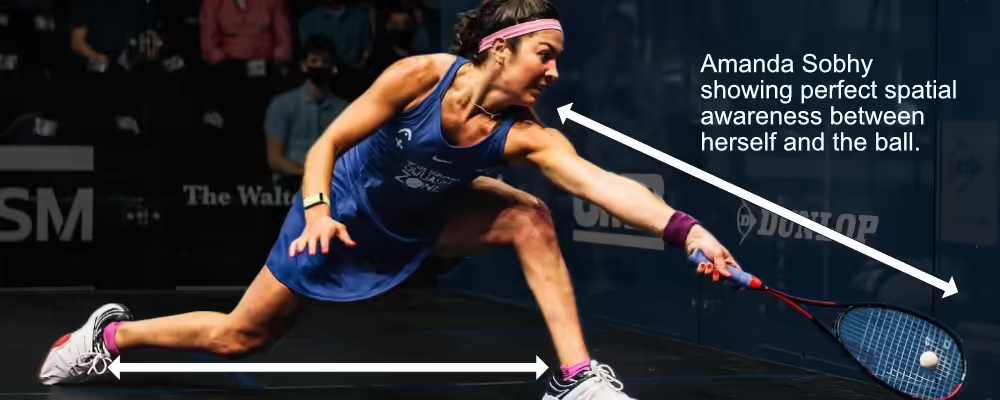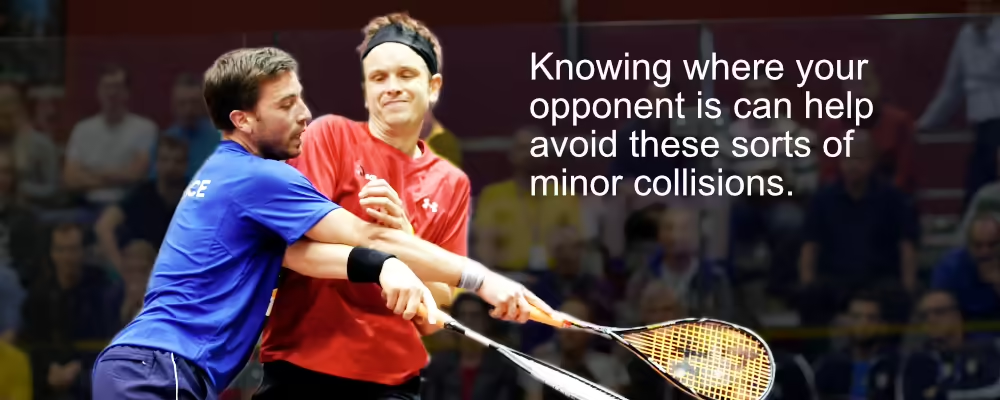21 December 2023 / 4-Min Read / Translate
Before you panic and think that this is going to be an academic or scientific paper - relax. This is a short introduction to spatial awareness in squash and more importantly how it can help you become a better squash player.
Let’s start by defining spatial awareness. It is knowing and understanding the relationship between your body and the objects around you. Which sounds pretty simple, and in many ways it is.
Standing on a squash court and looking around, there’s not many objects there, right? Well, there’s four walls that don’t move. An opponent who is constantly moving and the ball which should be moving too.
In addition to those things, there’s “you”. And in some ways, “you” is the most complex object on the court, in the sense that you can control all aspects of your movement (body, arm and legs). But perhaps we are getting a little ahead of ourselves. Let’s take each point in order.

It’s true that the court doesn’t move, but you do, so knowing where you are in relation to the walls is very important. The better your squash level, the less you need to consciously think about the walls. The front wall has little effect on you, but the side walls and back wall do.
You should be able to place a folded sticky note on the wall and swing and hit it without significantly touching the wall. Rackets break because they hit the wall, NOT because they scrape the wall. As a bookend drill I sometimes recommend some wall swings to become comfortable with your distance between the side wall and yourself.
The back wall can be more problematic for newer players, especially if they don’t have a technically competent swing. It’s easier to misjudge how close you are to the back wall, especially if you are focused on the ball in front of you. This is where spatial awareness starts to become important. Based simply on the visual distance from the front wall AND the lines on the floor, experienced players just “know” where the back wall is. How confident are you that your racket won't hit the back wall when you swing?'
Key Point:
The distance between you and the wall is critical to hitting clean shots. Spend some time feeling comfortable swinging close to the walls.
While you have some control over your opponent's position in a rally, game and match, that really only extends to where you put the ball. After they hit it, they could move in unexpected ways and to unexpected locations. Yes, we all expect them to return to the T (assuming both you and they know where that is).
Some players have the uncanny ability to “know” where you are when you play them, and other players seem completely oblivious to your location. When you first start to play squash, your total concentration needs to be on the ball and your swing. There’s no mental processing power left to focus on other aspects. It’s a little like when you first start to learn to drive a car; actually controlling the vehicle AND being aware of all that’s around you is difficult. But it does get easier.
The sound of your opponent’s footwork can be a good guide, but not always. In addition, it’s not unusual to see players actually look where an opponent is. Ideally, you would use your peripheral vision, the sound of your opponent and reasoning based on where you are and where your opponent was.
Key Point:
How can you decide where to hit your next shot if you don’t know where your opponent is? As you get better, you will be able to let the swing happen naturally and dedicate some of your attention to your opponent.

When you first start to play squash, judging the bounce, speed and distance to the ball *can* be challenging for some. Most new players adapt quickly. As your standard becomes higher, the ball moves faster, giving you less time to adapt. But the process is the same whether it's fast or slow. You need to be as close to the ball as necessary, but no closer. Too close and you have wasted effort and almost certainly limited your shot selection options.
Solo drilling, condition games and simply playing is generally all that is needed to improve your spatial awareness of the ball’s vector (direction and speed). Let’s not forget that after a ball hits a wall its vector changes and having experience of those changes makes a big difference to your ability to adapt.
Key Point:
The ball moves and bounces in consistent ways, but judging your movement in relation to the ball is the key, and there is no substitute for time on court.
Technically, awareness of yourself, i.e. “you” is described as “kinesthesia”, but as I mentioned at the beginning, this is not an academic paper. Being aware of the exact position of all parts of your body is absolutely vital in the ability to perform a complex action, such as a swing in racket sports. Even though the racket isn’t your body, it should feel like an extension of it.
In addition, it’s important to combine this idea with the court, which was our first point. You have two aspects here, the finer control of judging the distance between your racket and the wall when swinging and the more gross aspect of your position on court.
There was a time when I performed some ghosting with my eyes closed. Crazy, right? Well, the idea was that I should really know where I was based on the movement of my feet. I don’t use it now as I feel that it’s an extreme that doesn’t help. I wouldn’t be surprised if pros could do it really well though.
So for this article, we are interested in your ability to know where you non-racket arm is or the angle of your racket head.
Key Point:
Simply paying more attention to your body and its position on court can allow you to develop habits, such as staying away from the side walls and “hitting and moving” immediately.
If we are too engrossed in trying to win points or hit the ball hard, we might forget that those things depend on other things. Squash players generally have good spatial awareness due to the fact that they share a small, limited space with their opponent.
But by thinking more about your and your opponent’s position on the court, we can develop a better tactical awareness and choose our shots with more thought.
I’m not expecting you to suddenly develop “SpiderMan senses”, but start by asking yourself “Do I know where my opponent is when I play my shot?”. If not, try to.